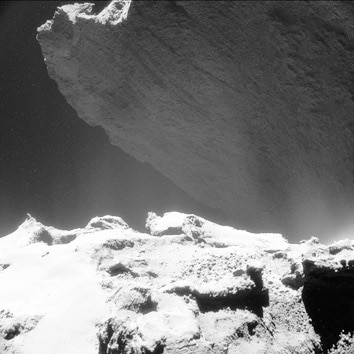Create a free profile to get unlimited access to exclusive videos, sweepstakes, and more!
The Cliffs of Churyumov-Gerasimenko

The Rosetta spacecraft hasn’t been in the news much lately, but wow, is it the gift that keeps on giving. Check out this magnificent view of the comet 67P/Churyumov-Gerasimenko, looking past the Seth region on the big lobe to the towering Hathor cliffs on the small one:
Oh, my.
67P is a double-lobed beast, a 4-kilometer-long cosmic rubber ducky. It’s not clear why it (and so many other comets and asteroids) have this bowling pin or dumbbell shape; maybe it’s from two objects colliding slowly and sticking together, or one bigger object slowly eroding away as ice inside the comet gets heated to a gas by sunlight and vents into space.
Those cliffs are a clue, but what they’re telling us isn’t clear. They reach 900 meters high and are striated with linear features, looking very much like the comet has been cleaved right there.
That view is strengthened, perhaps unfairly, when you look at the comet in context. This mosaic shows 67P taken at a different time, but viewed from almost the exact same angle, and the lower left quadrant shows the same part of the comet as seen above:
It really looks like it has a bite taken out of it! It’s not hard to imagine this started off as a more elongated, somewhat cylindrical object, and that over the eons a vent in the side kept getting bigger and bigger, eating away into the body of the comet.
Interestingly, you can see ice doing just that from Seth; if you brighten the top image a bit and drop the contrast, the streams of gas flowing away can be clearly seen.
But all this could be coincidence; the comet is a bizarre, alien landscape, and interpretation is difficult. Our sense of what can happen there may be biased by our more terrestrial experience, and we have to be careful to remember: This is in space, has little gravity, is composed of loosely conglomerated gravel and ice, and is sculpted by escaping gas and the rare impact rather than wind and sea. It’s easy to follow the garden path of reason to a completely wrong conclusion here.
But it’s fun to think about, isn’t it?


























